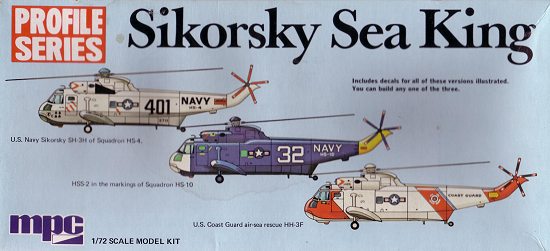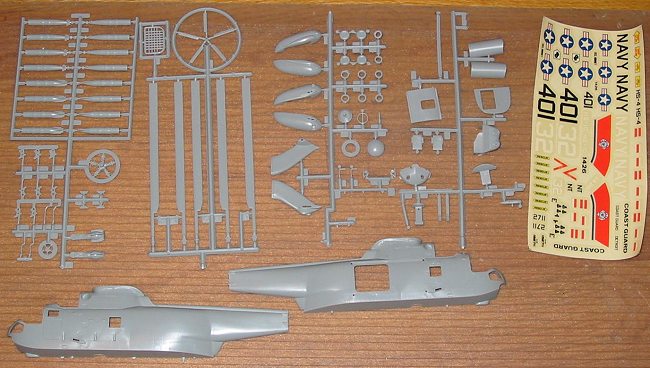
|
KIT: |
MPC 1/72 SH-3 Sea King |
|
KIT # |
2-515 |
|
PRICE: |
$ About a buck when new! |
|
DECALS: |
Three aircraft. |
|
REVIEWER: |
Bill Michaels |
|
NOTES: |
Wrong Version for USCG markings. |

|
HISTORY |
The SH-3 was designed as an ASW helicopter, and entered US Navy service in 1961. Follow-on versions were developed for minesweeping and Air-Sea Rescue, and the SH-3 was also used in astronaut recovery. The H-3 has been used by the US Navy, Air Force, and Coast Guard. The H-3 has also been used by the Royal Danish Air Force, the Spanish Navy, and licensed versions were produced by Mitsubishi in Japan, Augusta in Italy, Unites Aircraft Corp. in Canada, and by Westland in the United Kingdom.
|
THE KIT |

First off, I’ll say that I built a copy of this kit around 1979. I bought and built it as a USCG model, and did not realize at the time that the model is a poor representation of a USCG HH-3F Pelican. I don’t recall any difficulties in assembling the kit back then. I recently picked up a copy on Ebay, and have taken another look at this old kit, with a more critical eye…..
MPC released a number of kits in “Profile Series” boxes. Generally, they came with the necessary parts, painting instructions, and decals to make one of three different version of an aircraft. When they were o the shelf on the local shop, they seemed pretty fancy at the time. They had this illusion of accuracy- the color profiles on the cover, the use of the word “Profile”, and the way the aircraft were supposed to represent a certain version from a certain squadron.
In this case, the accuracy illusion doesn’t hold up. The inclusion of US Coast Guard markings for this aircraft is just wrong. The USCG only operated the HH-3F, which has a different aft fuselage. The HH-3E and -3F have a cargo door in the rear of the cabin area, sort of like the door at the back of a C-130. The boat hull type of fuselage in this kit is the Navy version, not the USCG one.
There is no copyright or other date marking anywhere on the box or the instructions, but the kit looks like the first one I bought back in the late 1970s. The box does carry a statement that the kit is “Licensed by Airfix.”
The kit consists of about 100 parts, molded in a light gray. Panel lines are recessed on the fuselage, and raised on other parts, but they are very finely molded. (No trenches or ridges.) There are very fine raised rivets, which look good. When I first picked up the parts, I thought the rivets were recessed as well, and I had to run my fingers over them a few times to convince myself they were raised.
My model has very clean moldings— no signs of mold mis-alignment, and no flash. The main cabin door rides in over-sized rails, so that it can be opened and closed. The model also includes a chamber in the middle of the fuselage for the dipping sonar. The model was designed so that you can suspend the sonar unit from thread, and then lower and raise the unit by rotating the main rotor. (Classic operating features from the 1970s!)
The kit includes 2 pilot figures, and a third figure for the rescue platform. The cockpit consists of seats, pilots, control sticks, and an instrument panel. The instrument panel does not have a decal- instead there is a likeness printed in the instructions, which you’re supposed to cut out and glue to the plastic part.
The instructions are printed on newsprint-like paper. The instructions are in English only, and include a page with left and right side profiles for painting and decal locations. Throughout the instructions, the differences in paint color and parts used are called out for the three different versions of the model.
The kit provides decals for the three versions on the boxtop. My kit’s decals look to be reasonably thin, but the printing is not really sharp. The different colors are properly registered, but there is some pixilation. The decals remind me of a picture printed on a low-end inkjet printer—they look OK until you get real close.
|
CONCLUSIONS |
Not recommended if you want a USCG HH-3F Pelican. The aft fuselage shape is for an SH-3H, and not the -3F.
I have limited expertise in the area of helicopters— US Coast Guard models are the extent of my knowledge. I can’t tell you how this model compares to other SH-3 kits on the market. The moldings look nice, but you’ll probably end up replacing the decals.
Recommended for the US Navy versions if you take it for what the Profile Series was: Airfix kits with multiple paint and decal schemes.
If you want to build a USCG HH-3F Pelican, you should start with an Aurora or Lindberg US Air Force H-3 Jolly Green Giant. These are kits of the USAF HH-3E, which has the fuselage that the USCG HH-3F was based on.
Review courtesy of me and my wallet.
If you would like your product reviewed fairly and quickly by a site that has well over 150,000 visitors a month, please contact me or see other details in the Note to Contributors.